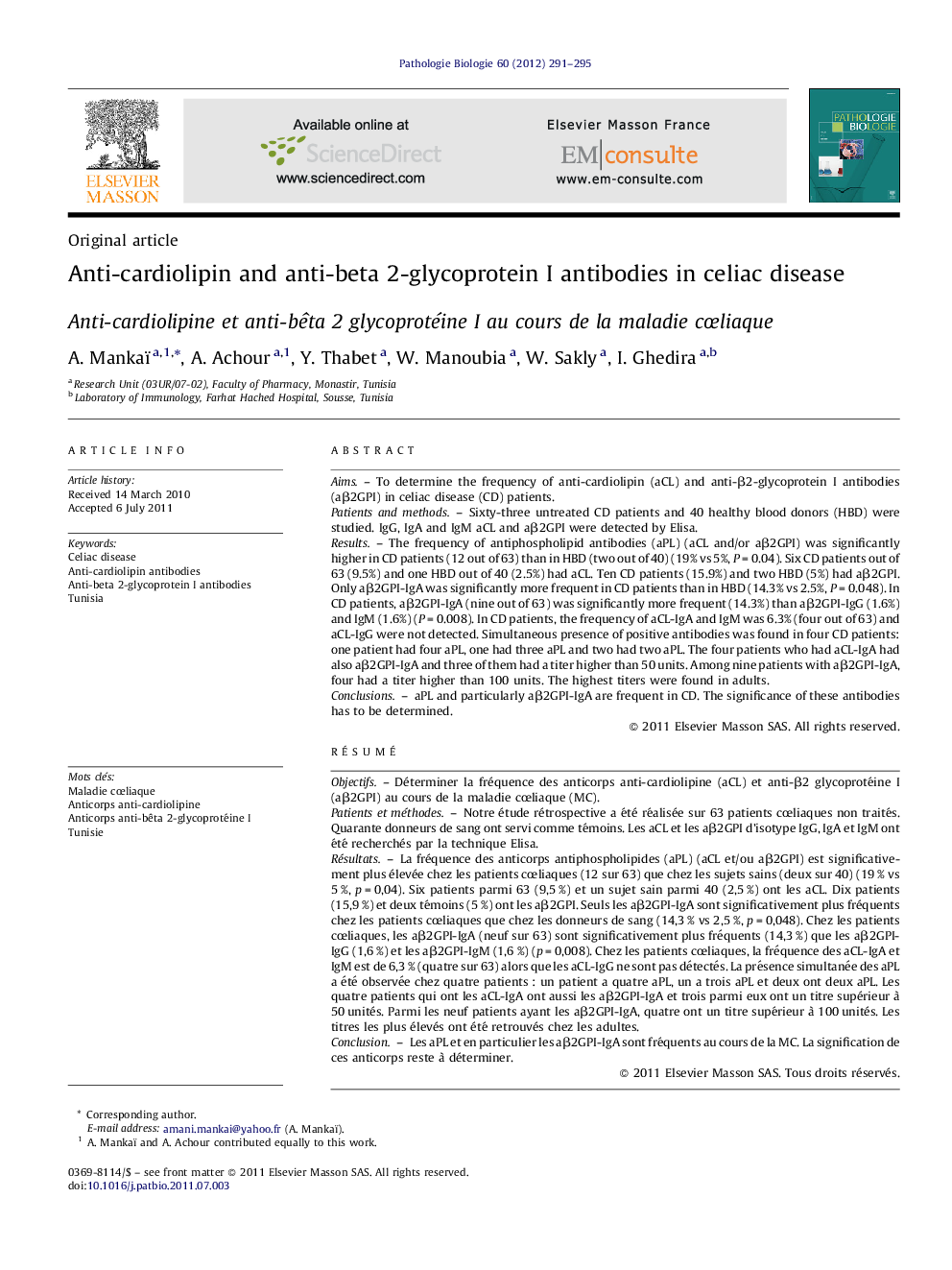| Article ID | Journal | Published Year | Pages | File Type |
|---|---|---|---|---|
| 4136109 | Pathologie Biologie | 2012 | 5 Pages |
AimsTo determine the frequency of anti-cardiolipin (aCL) and anti-β2-glycoprotein I antibodies (aβ2GPI) in celiac disease (CD) patients.Patients and methodsSixty-three untreated CD patients and 40 healthy blood donors (HBD) were studied. IgG, IgA and IgM aCL and aβ2GPI were detected by Elisa.ResultsThe frequency of antiphospholipid antibodies (aPL) (aCL and/or aβ2GPI) was significantly higher in CD patients (12 out of 63) than in HBD (two out of 40) (19% vs 5%, P = 0.04). Six CD patients out of 63 (9.5%) and one HBD out of 40 (2.5%) had aCL. Ten CD patients (15.9%) and two HBD (5%) had aβ2GPI. Only aβ2GPI-IgA was significantly more frequent in CD patients than in HBD (14.3% vs 2.5%, P = 0.048). In CD patients, aβ2GPI-IgA (nine out of 63) was significantly more frequent (14.3%) than aβ2GPI-IgG (1.6%) and IgM (1.6%) (P = 0.008). In CD patients, the frequency of aCL-IgA and IgM was 6.3% (four out of 63) and aCL-IgG were not detected. Simultaneous presence of positive antibodies was found in four CD patients: one patient had four aPL, one had three aPL and two had two aPL. The four patients who had aCL-IgA had also aβ2GPI-IgA and three of them had a titer higher than 50 units. Among nine patients with aβ2GPI-IgA, four had a titer higher than 100 units. The highest titers were found in adults.ConclusionsaPL and particularly aβ2GPI-IgA are frequent in CD. The significance of these antibodies has to be determined.
RésuméObjectifsDéterminer la fréquence des anticorps anti-cardiolipine (aCL) et anti-β2 glycoprotéine I (aβ2GPI) au cours de la maladie cœliaque (MC).Patients et méthodesNotre étude rétrospective a été réalisée sur 63 patients cœliaques non traités. Quarante donneurs de sang ont servi comme témoins. Les aCL et les aβ2GPI d’isotype IgG, IgA et IgM ont été recherchés par la technique Elisa.RésultatsLa fréquence des anticorps antiphospholipides (aPL) (aCL et/ou aβ2GPI) est significativement plus élevée chez les patients cœliaques (12 sur 63) que chez les sujets sains (deux sur 40) (19 % vs 5 %, p = 0,04). Six patients parmi 63 (9,5 %) et un sujet sain parmi 40 (2,5 %) ont les aCL. Dix patients (15,9 %) et deux témoins (5 %) ont les aβ2GPI. Seuls les aβ2GPI-IgA sont significativement plus fréquents chez les patients cœliaques que chez les donneurs de sang (14,3 % vs 2,5 %, p = 0,048). Chez les patients cœliaques, les aβ2GPI-IgA (neuf sur 63) sont significativement plus fréquents (14,3 %) que les aβ2GPI-IgG (1,6 %) et les aβ2GPI-IgM (1,6 %) (p = 0,008). Chez les patients cœliaques, la fréquence des aCL-IgA et IgM est de 6,3 % (quatre sur 63) alors que les aCL-IgG ne sont pas détectés. La présence simultanée des aPL a été observée chez quatre patients : un patient a quatre aPL, un a trois aPL et deux ont deux aPL. Les quatre patients qui ont les aCL-IgA ont aussi les aβ2GPI-IgA et trois parmi eux ont un titre supérieur à 50 unités. Parmi les neuf patients ayant les aβ2GPI-IgA, quatre ont un titre supérieur à 100 unités. Les titres les plus élevés ont été retrouvés chez les adultes.ConclusionLes aPL et en particulier les aβ2GPI-IgA sont fréquents au cours de la MC. La signification de ces anticorps reste à déterminer.
